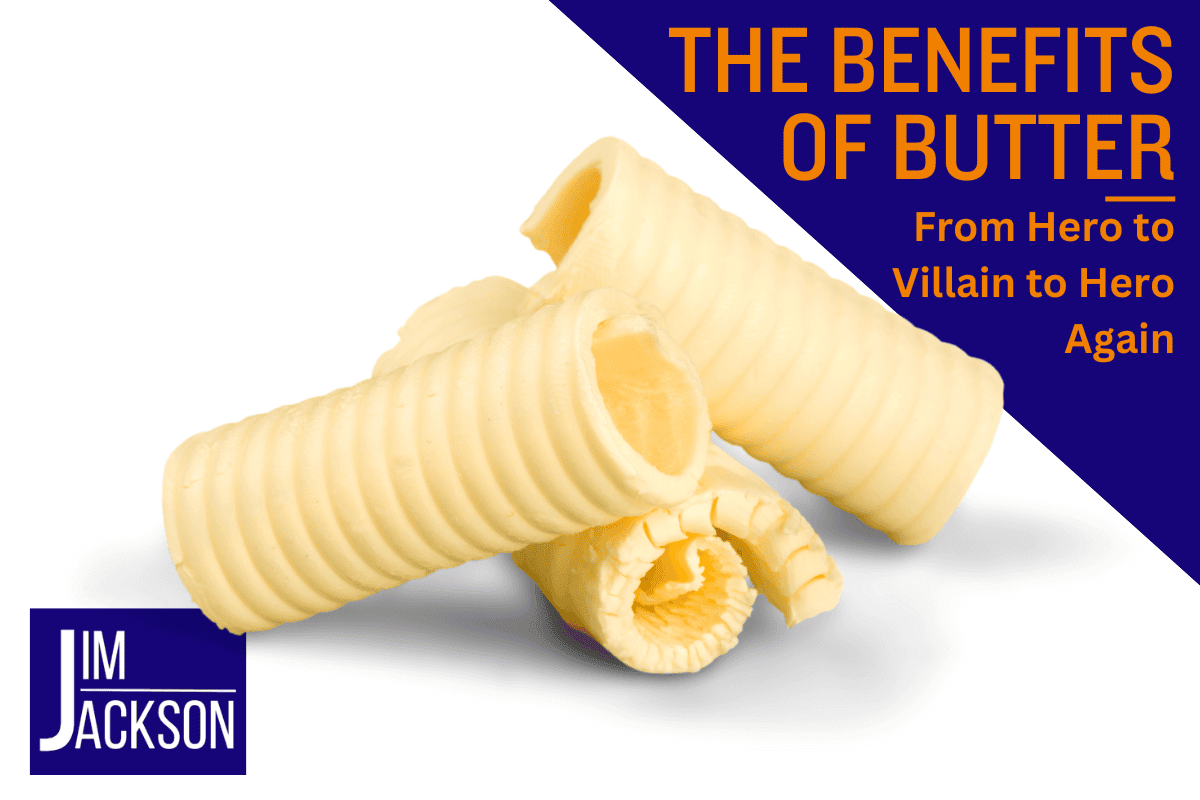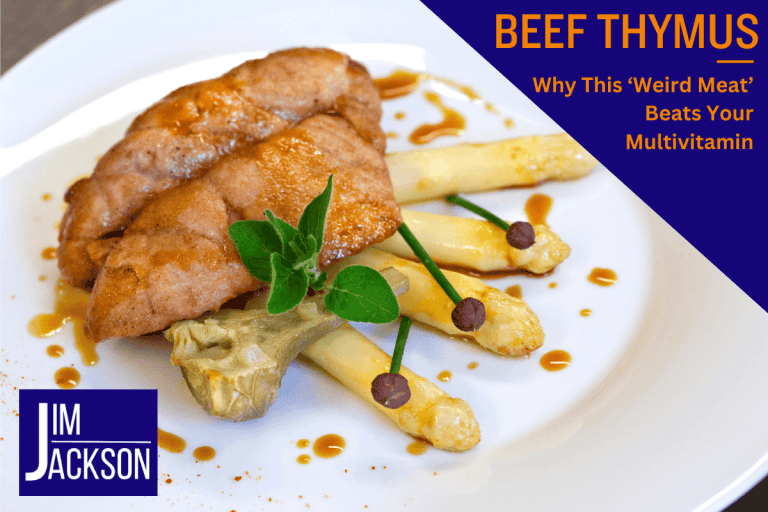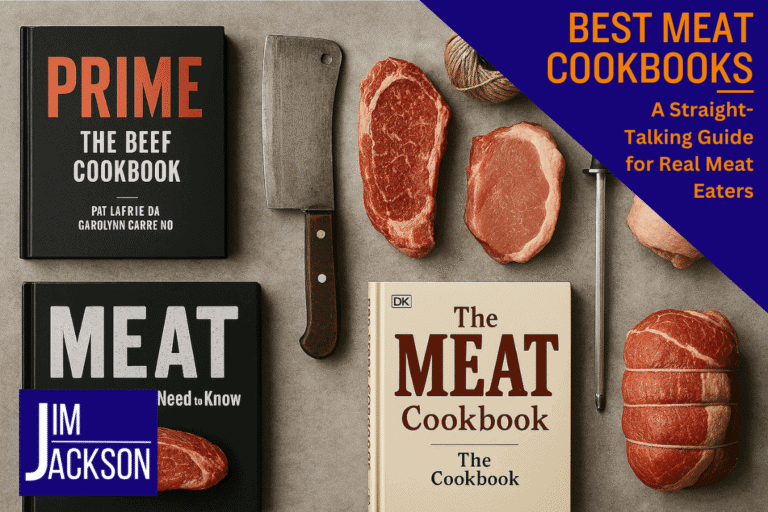The Benefits of Butter: From Hero to Villain to Hero Again
Butter’s had a rough time over the years. One minute, it’s on the naughty list; the next, it’s making a comeback. So, what’s the truth?
Is butter a delicious, natural fat we’ve enjoyed for thousands of years? Or is it just a slab of saturated fat waiting to clog your arteries?
We’ve been told to ditch butter for shiny tubs of vegetable oils and “heart-friendly” spreads. But if butter’s so bad, why does it taste so good — and why are people turning back to it?
Here’s what we’ll unpack:
- What butter really is and how it’s made
- Its proper place in a healthy diet
- Why your ancestors likely enjoyed butter, without worrying about heart disease
- And why I eat butter every day (sometimes straight from the block while cooking — no shame!)
By the end, you’ll know exactly why butter isn’t just tasty — it’s packed with genuine health benefits too.
Right, let’s get straight into it and discover the health benefits of butter.
TL;DR
- Butter is rich in healthy fats, fat-soluble vitamins, and natural nutrients like conjugated linoleic acid and butyric acid, which support heart health, immune function, and bone growth.
- Butter (especially grass-fed) offers better nutritional quality than spreads made from vegetable oils or plant oils, and it delivers a superior, rich flavor and creamy texture.
- The fear of saturated fat intake and heart disease risk has been overstated — modern research shows natural high-fat dairy products like butter can be part of a healthy diet.
- Butter is real food, made by simply churning milk, unlike highly processed oils and spreads; enjoy it daily in butter coffee, melted over steamed veggies, or even straight from the block!
What is Butter, Really?

At its core, butter is simple. It’s made by churning milk — usually cow’s milk — until the milk fat separates from the milk solids. What’s left is that rich, creamy block we all know and love.
The process of making butter has barely changed in thousands of years. Our ancestors, especially those living with herds of cows, would have made traditional butter by hand, using nothing more than fresh cream and a bit of elbow grease. No factories, no additives, no chemical processing.
The big question, though, is whether butter is a processed food? Technically, yes — but here’s the important part. It’s minimal processing. Churning milk is about as natural as it gets. There’s no comparison to the heavy industrial refining used to make plant oils and vegetable & seed oils.
Butter is made from real, whole food ingredients. Most importantly, grass-fed butter offers even better nutritional quality, because cows grazing on fresh grass produce butter richer in fat-soluble vitamins, conjugated linoleic acid, and that signature golden colour thanks to beta carotene.
And let’s not forget the creamy texture and rich flavor. These aren’t just tasty bonuses — they’re signs of the good stuff inside.
So, no—butter is not some lab-made mystery spread. It’s real food, made from cow’s milk, and enjoyed by humans for generations.
Next, let’s dig into what makes butter such a nutritional powerhouse.
The Nutritional Power of Butter and Its Health Benefits

Butter isn’t just about flavor, though let’s be honest, the rich flavor and creamy texture are hard to beat. Beyond that, butter is loaded with nutrients that support your whole body.
Butter’s Fatty Acids: Fuel for Your Body
First up, let’s talk about fatty acids.
Butter is high in saturated fat, and despite the bad press, this isn’t something to fear. In fact, saturated fat intake is essential for building healthy cells, producing hormones, and even supporting your brain.
What’s more, butter contains conjugated linoleic acid, a natural fatty acid found in high-fat dairy products. Studies on conjugated linoleic acid effects show potential support for fat loss and even protection against certain chronic diseases like breast cancer.
It’s not a magic bullet, but it’s certainly a natural ally.
Then we have butyric acid. Butter is one of the richest dietary sources of this short-chain fatty acid, which plays a key role in supporting your digestive system and reducing inflammation. Simply put, it helps keep your gut happy.
Vitamins, Minerals, and Extra Health Benefits
Butter also delivers a good dose of fat-soluble vitamins like vitamin E, which is known for its antioxidant powers. And thanks to cows grazing on fresh grass, grass-fed butter is a rich source of beta carotene — the body converts this into vitamin A, essential for eye health and immunity.
There’s more. Milk fat in butter contains unique compounds that may support bone growth, improve immune function, and even protect your blood vessels. It’s a full package of goodness.
To sum up, butter offers real, measurable health benefits — not just old wives’ tales. It’s a natural, nourishing fat that plays a positive role in your diet when enjoyed sensibly.
Grass Fed Butter: Why It Matters More Than You Think

Not all butter is created equal. If you’ve only ever grabbed standard butter from the supermarket shelf, you’re missing out on the real star of the show: grass-fed butter.
The Power of Fresh Grass and Grass-Fed Cows
When cows are fed fresh grass rather than grains, it changes the butter entirely. Grass-fed cows produce milk that’s richer in nutritional quality, leading to butter that’s higher in fatty acids, vitamin E, and beta carotene.
That’s what gives grass-fed butter its deep yellow colour — a natural sign of its nutritional value.
More importantly, it boosts the conjugated linoleic acid content and improves the balance of free fatty acid contents, giving you more of the good stuff with every bite.
Rich Flavor, Creamy Texture, and Real Health Benefits
Besides the clear health benefits, there’s the taste. Grass-fed butter delivers a rich flavor and creamy texture that factory-farmed alternatives just can’t match.
That’s not just about indulgence — it’s about eating butter that comes from healthier animals, living more naturally, which often means a healthier fat profile for you.
If you’re eating butter daily (like I do), it makes sense to go for the best. Grass full-fat butters from grass-fed cows are your top choice for both flavour and function.
Butter vs. Plant Oils: A Common-Sense Comparison

For years, we were told to swap butter for plant or seed oils and vegetable oils. The argument? They contain unsaturated fats, which were marketed as the heroes of heart health. But let’s stop and think for a second.
Would our ancestors have had access to plant oils like canola, soybean, or sunflower oil? Not a chance.
Thanks to industrial processing, these oils only became part of our diet in the last century. You don’t squeeze a sunflower and get oil — you need factories, chemicals, and high heat to get that bottle on the shelf.
Replacing Saturated Fat: Does It Actually Work?
The push for replacing saturated fat with polyunsaturated fats came from early theories about fat and heart disease.
But modern human studies are far less clear-cut. Some even show that loading up on polyunsaturated fats and trans fats from plant oils and margarines may increase your risk of heart disease.
Meanwhile, grass-fed butter, with its natural saturated fat and conjugated linoleic acid, has been unfairly blamed. In reality, dietary fats like butter may support heart health rather than harm.
Butter, Coconut Oil, and Olive Oil: Real Food Fats
If you’re looking for natural fats, stick with what’s stood the test of time: butter, coconut oil, and olive oil. These fats come from traditional methods and plant foods or animal sources that don’t rely on industrial processing.
Better yet, butter gives you fat-soluble vitamins, butyric acid, and that rich source of nutrients that processed oils just can’t offer.
The bottom line? When it comes to choosing fats, butter contains what nature intended — no refining, no funny business, just real food.
How Butter Got a Bad Rap (And Why It’s Coming Back)

Back in the mid-20th century, butter became the villain thanks in large part to Ancel Keys and his Seven Countries Study.
Blamed for rising rates of heart disease, doctors and public health officials urged people to cut back on saturated fat and switch to unsaturated fats from seed oils and margarines instead.
After finding cholesterol in diseased arteries, the idea was simple: replacing saturated fat would lower cholesterol and reduce your heart disease risk. Seems logical, right?
Unfortunately, nothing is that straightforward.
The Rise of Margarine and Industrial Oils
This shift gave rise to products made with vegetable oils, plant oils, and later, trans fats, which we now know are far worse for your health than butter ever was.
Some of the same health bodies that once warned against butter are now backtracking, after years of new data and better fatty acid profiling.
And still, heart disease remains the world’s leading cause of death. So maybe it’s time we stopped blaming real food and started questioning processed food.
The Return of High–Fat Dairy Products
Now, high-fat dairy products like butter are making a comeback. More people are looking at food through a common-sense lens — and realising that maybe, just maybe, nature got it right the first time.
Butter is no longer the enemy. For many, it’s a daily staple again, especially when sourced from grass-fed cows, not factories.
Common Sense Check: What Would Our Ancestors Have Eaten?

When in doubt, I always go back to this simple question: What would our ancestors have eaten?
They didn’t have margarine, vegetable oils, or any of the ultra-processed spreads lining supermarket shelves today. But they did have butter.
Once they figured out churning milk, butter became a natural way to enjoy the goodness of cow’s milk long after the milk itself would spoil.
Traditional Butter from Grass-Fed Cows
Think about it. Cows fed fresh grass produce rich, nourishing milk. Turn that milk into butter, and you get a fat source packed with fat-soluble vitamins, milk fat, and a healthy dose of conjugated linoleic acid.
It’s simple, natural, and time-tested.
Now compare that to margarine or plant oils, which rely on industrial refining, chemical solvents, and high heat processing. Does it make sense that something so far removed from nature is better for our health?
Simple Logic Cuts Through Confusion
There’s a lot of noise about saturated fat intake, risk of heart disease, and replacing saturated fat with so-called alternatives. But strip it back, and it’s common sense.
Would you rather eat butter that contains natural fats from cows, or chemically altered fats that have only been around for the blink of an eye in human history?
If you squeezed a seed with your fingers, how much oil would you get out of it? None… nada!
Trust me when I say that seeds need to go through a massive process to become the so-called healthy liquid called seed oil. It’s extracted from the seeds using chemicals, re-colored, and reoderized. It’s not natural at all.
For me, the choice is clear. I’ll take grass-fed butter every time — and not just for its rich flavor and creamy texture.
How to Enjoy Butter Daily

If you’ve been avoiding butter, I’ve got good news — it’s time to bring it back. And not just as an occasional treat. There are plenty of simple, satisfying ways to enjoy butter daily.
Eat It Straight (Yes, Really)
This might surprise you, but you’ll often catch me eating small pieces of butter straight while cooking.
A bite here and there not only tastes great, but it also gives you a quick hit of healthy fats and fat-soluble nutrients.
Melted Butter and Butter Coffee
A dollop of melted butter over steamed veggies transforms them from bland to brilliant. It adds richness, improves the absorption of fat-soluble vitamins, and let’s be honest, it just tastes better.
Then there’s butter coffee. Blend some unsalted butter into your morning brew for a creamy, satisfying start to the day.
Made famous by Dave Asprey and his Bulletproof Coffee, it’s a simple, effective way to fuel your body with healthy fats and skip the mid-morning crash. And, it tastes amazing!
Sweet and Savoury Pairings
Butter also pairs beautifully with a few sweet treats. Try it with dark chocolate, a drizzle of honey, or even with dates and prunes. The rich flavor and creamy texture balance the sweetness perfectly.
I kid you not… they are taste sensations… give them a go.
And if you want to get fancy, whipped butter or clarified butter (ghee) are great options too. Both offer unique textures and flavours while keeping all the natural goodness of butter intact.
My Take: Why Butter Deserves a Place on Your Plate

I’ll keep this simple. Butter just makes sense.
It’s real food, made from cow’s milk, not something cooked up in a factory. Butter contains natural fat content and nutrients your body knows how to use.
When it’s from grass-fed cows, it’s even better — packed with beta carotene, vitamin E, fat-soluble vitamins, and healthy, natural saturated fat.
I eat butter daily. Not just a little bit here and there — I genuinely enjoy it. Whether it’s straight off the knife while cooking, blended into coffee, or spread thick on something sweet, butter is part of my routine.
And I feel better for it. Steadier energy, no wild cravings, and I get to enjoy that rich flavor and creamy texture every day. Fueling my body with real, natural fat and ditching the human-made fat is one of the major factors that helped my recovery from chronic fatigue syndrome.
Plus, it’s reassuring to know I’m choosing something our ancestors would recognise as food, not an industrial fat pumped full of trans fats or stabilisers.
We’ve spent too long fearing natural fats like butter, thanks to decades of mixed messages about heart disease risk and saturated fat intake. But common sense — and better research — tells us butter deserves a place back on your plate.
So, enjoy it. Enjoy it daily if you like. Just make sure it’s the good stuff: grass-fed butter from grass-fed cows, with all the nutritional quality nature intended.
Conclusion: Butter is Back — And It’s Here to Stay

Butter is no longer the villain it was made out to be. The truth is simple: butter is real food, rich in healthy fats, fat-soluble vitamins, and valuable nutrients your body needs.
Forget the fear around saturated fat intake and heart disease risk.
We now know that natural fats, especially from grass-fed butter, offer genuine health benefits — from supporting heart health and bone growth, to keeping your immune function and digestive system strong.
Butter has stood the test of time. Our ancestors valued it, not because of trendy diets, but because it was nourishing, energy-dense, and straight from nature.
No industrial processing. No chemicals. Just the goodness of cows fed fresh grass, turned into something delicious and beneficial.
It’s part of an animal-based diet, or what I call the Ultimate Human Diet, and is what humans have been eating long before human-made foods and fats were around.
So, bring butter back to your table. Cook with it, spread it thick, melt it over your food, or enjoy it straight while you’re prepping dinner. Embrace the natural fat that humans have thrived on for generations.
And most of all, enjoy every bite guilt-free.
And that’s it… have a nutritious day!
FAQs
Is butter bad for your heart health?
No. Despite old beliefs, butter contains natural saturated fat, not harmful trans fats. In fact, newer research suggests butter may support heart health when eaten as part of a balanced, real-food diet.
What’s the difference between grass-fed butter and regular butter?
Grass-fed butter comes from cows fed fresh grass, which boosts its nutritional value. It’s higher in conjugated linoleic acid, beta carotene, and vitamin E, giving you more health bang for your buck.
Can eating butter every day support immune function?
Yes. Butter is rich in fat-soluble vitamins and milk fat compounds that play a role in supporting your immune function and overall health.
How does butter compare to olive oil or avocado oil?
Butter, olive oil, and avocado oil are all natural fats. Butter offers butyric acid, conjugated linoleic acid, and fat-soluble nutrients. Oils from plant foods are great too, but butter brings something unique: the taste and nourishment of high-fat dairy products.
Does butter contain trans fats?
Butter naturally contains tiny amounts of trans fats, but they’re very different from the industrial types found in processed spreads. Natural trans fats from dairy have not been linked to the same risks.
Is melted butter better for cooking?
Absolutely. Melted butter adds depth of flavour and helps your body absorb fat-soluble vitamins from your meals, especially when poured over steamed veggies.







